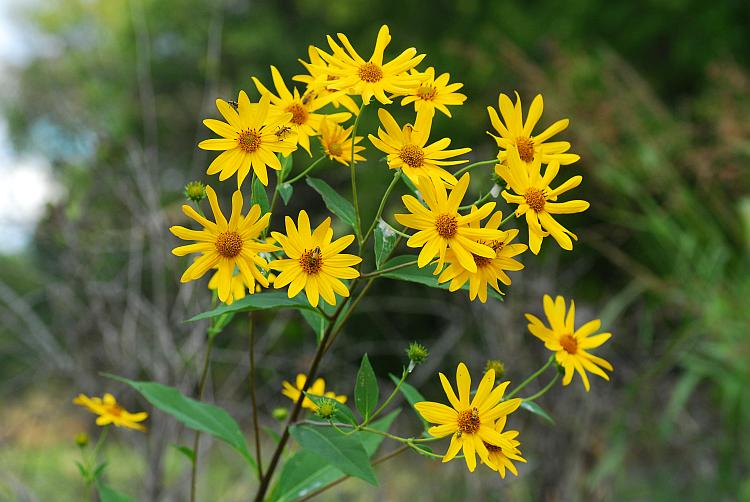Helianthus tuberosus L.
Jerusalem Artichoke

Native
CC = 3
CW = 3
MOC = 72
© SRTurner
Helianthus tuberosus L.Jerusalem Artichoke | |
 |
Native CC = 3 CW = 3 MOC = 72 |
© SRTurner |
|
Family - Asteraceae/Heliantheae Habit - Perennial forb with slender, long-creeping, branched rhizomes, the branches usually with small tubers at the tip, often found in colonies. Stems - Erect, sometimes somewhat sprawling late in season, up to 3 m tall, stout, sparsely to densely pubescent with bristly, whitish to silvery hairs.
Leaves - Usually opposite on lower stem, becoming alternate near inflorescence, well-developed along stem, with winged petioles. Blades to 25 cm, ovate, thick textured, flat, sharply pointed, toothed along margins, upper surface strongly roughened, lower surface densely pubescent, with 3 main veins, the lateral veins branching from the midvein well above the base.
Inflorescence - Solitary heads or, more commonly, open panicles, often with numerous heads.
Involucres - Involucre 8-12 mm long, 10-25 mm in diameter, the bracts in 3 or 4 overlapping series, lanceolate, tapered to a sharply pointed tip, the margins with a fringe of short hairs, the outer surface glabrous or pubescent.
Heads - Up to 8 cm in diameter. Receptacle convex to short-conical, the chaffy bracts 8-9 mm long, narrowly oblong to narrowly oblong-oblanceolate, usually with 3 short, sharply pointed lobes at the tip, these green or straw-colored, minutely hairy toward the tip.
Florets - Ray florets 10-20, sterile, the corolla 2-4 cm long, the outer surface with sparse to moderate, minute hairs and usually also scattered, minute, sessile, yellow glands. Disc florets perfect, numerous, the corollas 6-7 mm long, yellow. Pappus of 2 scales 2-3 mm long, these lanceolate to narrowly triangular, sharply pointed, often with a minute awnlike tip.
Fruits - Achenes 5-7 mm long, wedge-shaped, somewhat flattened and more or less 4-angled in cross-section, the surface mostly glabrous, brown, sometimes purplish-tinged.
Flowering - August - October. Habitat - Streambanks, forests, sloughs, pond margins, roadsides, pastures. Origin - Native to the U.S. Lookalikes - Other species of Helianthus, particularly H. hirsutus, H. strumosus, and others; also Heliopsis helianthoides and, broadly, numerous other species in the Asteraceae. Other info. - This showy, staturesque plant grows throughout Missouri and is a common sight along roadsides. It is a member of a complex of Helianthus species which can present significant challenges to identification. This one is relatively easy, having distinctive whitish, bristly hairs along a robust stem and large, ovate leaves with a winged petiole. The leaf arrangement usually moves from opposite to alternate high on the stem, and when this is seen in combination with the other characters it is nearly conclusive evidence for the species. Photographs taken along the Katy Trail, Warren County, MO, 9-22-2013; Tyson County Park, St. Louis County, MO, 8-28-2017; near Catawissa Conservation Area, Franklin County, MO, 9-11-2018; and at Shaw Nature Reserve, Franklin County, MO, 9-12-2018 and 10-2-2018 (SRTurner). |